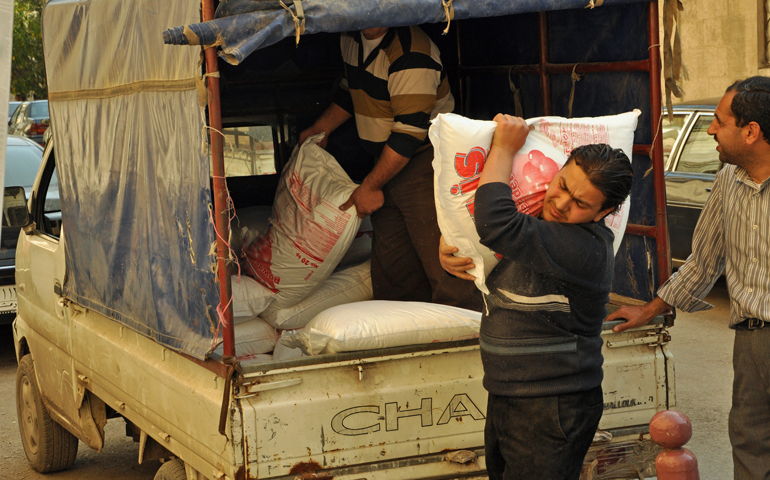
Men unload food at a Jesuit Refugee Service distribution warehouse in Aleppo, Syria. (Jesuit Refugee Service Aleppo)
"The humanitarian crisis in Syria is much worse than I thought," said Vatican official Msgr. Giampietro Dal Toso during a meeting Oct. 31 with U.S. journalists in Beirut.
Dal Toso, secretary of the Pontifical Council Cor Unum for Human and Christian Development, had just returned from a four-day visit to the Syrian capital of Damascus. Prior to the trip, he said he thought Syria's humanitarian crisis primarily pertained to refugees abroad. The severity of the war's impact on everyday life for those within the country surprised him. "We normally see war as some people fighting with arms, but there is this concrete consequence for ordinary people who were living in a very stable way," he said.
"This is not a religious war, but a political war with consequences for all the groups in the country," Dal Toso said.
Syria's conflict, which began in 2011, has affected almost half of its pre-war population of 22 million people. The U.N. Refugee Agency estimates nearly 3 million Syrians have become refugees and 6.5 million have fled their homes within Syria and are now internally displaced peoples.
On Oct. 28, foreign ministers from 20 countries and senior officials from 10 international aid organizations met in Berlin to discuss responses to Syria's worsening refugee crisis. A statement by 50 nongovernmental organizations released prior to the conference said violence and insecurity had left at least 4.7 million people within the country without a reliable supply of humanitarian aid. Restrictions from neighboring states have cut off avenues to international protection, leaving Syrians attempting to flee the conflict with "nowhere to go," the statement said.
Already taxed with more than 1 million Syrian refugees each, Lebanon and Jordan are closing their borders. Iraq no longer offers safe haven. While Turkey is still accepting Syrian refugees, reaching its border requires passing through many areas of fighting.
Dal Toso said life in Damascus is "apparently normal" despite the continual sounds of bombs and mortar fire heard in the background. The war's toll was evident nonetheless. Medicine for cancer is more expensive and harder to find. The middle class no longer exists, and the wealthy have left the country or become poor, he said.
"People are feeling this insecurity because of the war, because of lack of education for their children, because they don't know if they should go or stay," Dal Toso said.
The Vatican official met with Catholic bishops, religious communities, and representatives from Catholic aid organizations. Fifty currently operate in Syria. Thirty of these organizations belong to the Cor Unum network. The pontifical council oversees the coordination of Catholic aid agencies worldwide.
"The church is a very big player in the humanitarian effort [in Syria] and is well accepted by all the population," Dal Toso said. "The fact that we are helping all populations without regard to regard to religion, creed or race -- this is a very important factor in preparing for reconciliation in the future. Christians are the bridge."
But the nonpartisan assistance provided by Catholic aid agencies is often carried out at great risk, according to Zerene Haddad, a regional communications officer for Jesuit Refugee Service. A multireligious mix of 515 staff and volunteers work for the relief organization in the Syrian cities of Homs, Damascus, and Aleppo.
"Humanitarian workers are under a lot of pressure," Haddad said. "When visiting displaced families, you often move through areas that are not really safe. You are at risk from random mortar fire, shells, all kinds of projectiles. You are often in a lot of different neighborhoods as well, carrying goods with you, so that involves a lot of stopping, checkpoints, lots of questions, searching. People can view you with suspicion from one side or another."
Earlier this fall, Fr. Mourad Abu-Seif, a Jesuit priest known for assisting all sides, had to leave Syria due to security concerns. Mourad was project director at a JRS Center in Aleppo, a once scenic city now devastated by war. Established in 2008, the center initially served Iraqi refugees fleeing sectarian violence in their homeland then became a haven for victims of Syria's conflict.
"We were quite well-known for our work originally with Iraqis," Haddad said. "Our community center was in a neighborhood where a lot of different groups lived and moved through. It was very popular. As things became more and more polarized in the city, Mourad continued to be someone who was very much a peacemaker and would always be open to negotiating and doing his bit to protect civilians as much as possible. But that meant he was talking to a variety of people involved. It was not welcome the work he was doing by any of the aggressors.''
Bombed in 2012, the JRS center in Aleppo has relocated but continues to work in the city.
An October report by JRS described Aleppo as a city caught in the crossfire of government forces, rebel factions, and the Islamic Front, a merger of rebel groups involved in the Syrian civil war. Amid the fighting, many have fled, and Aleppo's population has dropped from 4 million people to 2 million. Most of the remaining inhabitants are crammed into the western side of the city, which is government-controlled and free of airstrikes.
Dal Toso said the crisis in Iraq "is tied to the humanitarian crisis in Syria. We have refugees from Iraq in Jordan and in Lebanon." Iraq overshadowed the Syrian situation, but from "our point of view, this is one crisis with different aspects," he said.
[Claire Schaeffer-Duffy is a longtime NCR contributor.]


